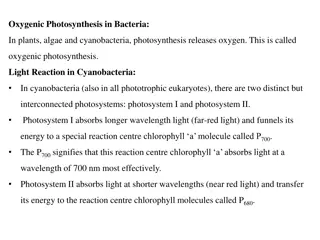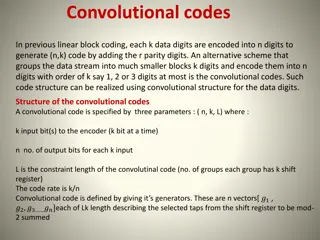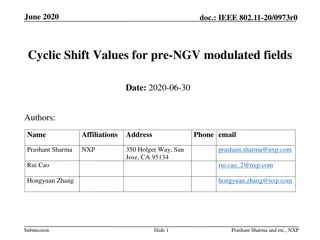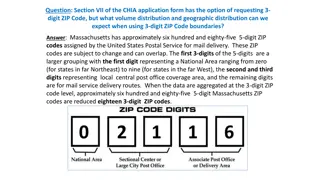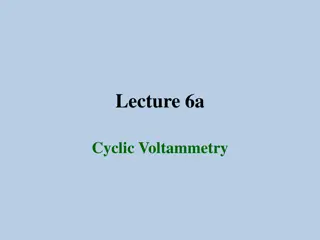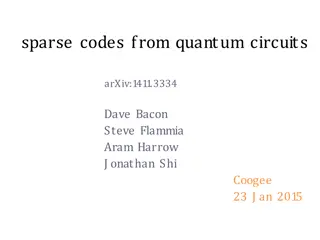Understanding Cyclic Codes: Generation and Examples
Cyclic codes are a subclass of linear block codes where any cyclic shift of a codeword results in another valid codeword. This article explains the generation of nonsystematic cyclic codes through polynomial multiplication and provides examples and code tables for both nonsystematic and systematic cyclic codes.
Download Presentation

Please find below an Image/Link to download the presentation.
The content on the website is provided AS IS for your information and personal use only. It may not be sold, licensed, or shared on other websites without obtaining consent from the author. Download presentation by click this link. If you encounter any issues during the download, it is possible that the publisher has removed the file from their server.
E N D
Presentation Transcript
1 Cyclic codes These are subclass from the linear block codes. The name cyclic comes from the fact that any cyclic shift of a codeword is another codeword. i.e, if [C1]=[0011010] is a codeword then [C2]=[0001101] is another codeword obtained from [C1] by a right circular shift. Generation of cyclic codes: a)Nonsystematic cyclic codes: (multiplicative ): As mentioned before a nonsystematic code is that code in which the information and parity bits are mixed and not separated at the output codeword [C]. A nonsystematic cyclic code is generated using polynomial multiplication: Procedure: (1)For [D]=[a1 a2 .. ak] data word, write the data word in terms of a power of a dummy variable x with a1 weighted as MSB (Most Significant Bit) and ak as LSB(Least Significant Bit). This arrangement is chosen similar to what we have in logic where the LSB lies in the right and the MSB lies in the left. Hence: D(x)=ak+ak-1 x+ak-2 x2+ .+a2 xk-2+ a1 xk-1 where ''+'' sign is mod-2 addition(Ex-OR). For example if [D]=[11101], then D(x)=1+x2+x3+x4 and if D(x)= x6+x2+1 then [D]=[1000101], and so on. (2)Multiply D(x) by what is called generator polynomial g(x) of order r=n-k. This g(x) is one or the multiplication of some factors of xn+1. Factorization of xn+1 is not always easy and is usually taken from tables. For example if n=7, then x7+1=(x+1)(x3+x2+1)(x3+x+1) in mod-2 addition, (i.e. these terms are multiplied together and similar terms cancels each other). Then for n=7, r=3, we can choose either g1(x)= x3+x2+1 or g2(x)= x3+x+1. Also note that for n=7, r=4, we can choose either g1(x)=(x+1)(x3+x2+1) or g2(x) =(x+1)(x3+x+1). (3)The output codeword polynomial will be C(x)=D(x) g(x) from which we can find the output codeword [C] . Ex: Write down the code table for the (7,4) nonsystematic cyclic code with generator polynomial g(x)=x3+x+1. 1
2 Solution: Here n=7, k=4, r=3, [D]=[a1 a2 a3 a4], so the table has 16 rows: i/p [D] o/p [C] a1 0 0 0 0 0 0 0 0 1 1 1 1 1 1 1 1 a2 0 0 0 0 1 1 1 1 0 0 0 0 1 1 1 1 a3 0 0 1 1 0 0 1 1 0 0 1 1 0 0 1 1 a4 0 1 0 1 0 1 0 1 0 1 0 1 0 1 0 1 c1 0 0 0 0 0 0 c2 0 0 0 0 1 1 c3 0 0 1 1 0 0 c4 0 1 0 1 1 0 c5 0 0 1 1 1 1 c6 0 1 1 0 0 1 c7 0 1 0 1 0 1 wi --- 3 3 4 3 4 Where: --if [D]=[0001], then D(x)=1 and C(x)=D(x)g(x)=x3+x+1 or [C]=[0001011] --if [D]=[0010], then D(x)=x and C(x)=D(x)g(x)=x(x3+x+1)=x4+x2+x or [C]=[0010110]. --if [D]=[0011], then D(x)=1+x and C(x)=D(x)g(x)=(1+x)(x3+x+1)=x3+x+1+x4+x2+x=x4+x3+x2+1 or [C]=[0011101] --if [D]=[0100], then D(x)=x2 and C(x)=D(x)g(x)=x2 (x3+x+1)=x5+x3+x2 or [C]=[0101100]. --if [D]=[0101], then D(x)=1+x2 and C(x)=D(x)g(x)=(1+x2)(x3+x+1)=x3+x+1+x5 +x3+x2=x5+x2+x+1,[C]=[0100111]. And so on, the rest of the table is left as a homework. Note that the Hamming weight wi is found from the output codeword[C]. 2
3 b) Systematic Cyclic codes (Division): The polynomial representation is also used here. The same method is used to choose the generator polynomial g(x) as in nonsystematic cyclic code. The procedure for the generation of (n,k) systematic cyclic code is as follows: (1) Find D(x) from [D] as before. (2)As before, select a generator polynomial g(x) of order r from the factorization table of xn+1. xr D(x) C(x) = x D(x) + Rem r (3)The output codeword will be: whereRem g(x) is the remainder of the long division of xr D(x) byg(x). (4) Use C(x) to find [C]. The output codeword [C] is now in systematic form since C(x) consists of two parts, the 1st is xr D(x) which is the same as information data bits shifted to the left by r positions. The 2nd is the remainder of the long division of [xrD(x)/g(x)] of order (r-1) which is the r LSB bits of the output codeword or the parity bits, hence:[C]=[a1 a2 ak c1 c2 .cr] which in systematic form. Ex: Write down the code table for the (7,4) systematic cyclic code generated by the generator polynomial g(x)=x3+x2+1. Solution: Here n=7, k=4, r=3: o/p [C] i/p [D] a1 a2 a3 a4 c1 c2 0 0 0 0 0 0 0 0 0 1 1 0 0 0 1 0 1 1 0 0 1 1 0 1 0 1 0 0 0 1 0 1 0 1 1 1 0 1 1 0 0 1 1 1 1 0 0 0 1 0 0 1 1 0 1 0 1 0 1 1 1 1 0 0 1 1 0 1 1 1 1 0 1 1 1 1 c3 0 1 1 0 1 0 wi --- 3 4 3 3 4 3
4 1 ---for [D]=[0001], D(x)=1, xrD(x)=x3 x3 x3+x2+1 x2+1 x3+x2+1 (x2+1) is the remainder and the long division stops since x2+1 has an order less than r. Hence: C(x)=x3+ x2+1, or [C]=[0 0 0 1 1 0 1]. Data parity Note that the remainder directly gives the r parity bits if written in binary form. x+1 x4 x4+x3+x x3+x x3+x2+1 x2+x+1 ---for [D]=[0010], D(x)=x, xrD(x)=x4 x3+x2+1 hence C(x)=x4+ x2+x+1, or [C]=[0 0 1 0 1 1 1]. ---for [D]=[0011], D(x)=1+x, xrD(x)=x3(1+x)=x4+x3 x x4+x3 x4+x3+x x3+x2+1 x hence C(x)=x4+ x3+x, or [C]=[0 0 1 1 0 1 0]. And so on, the rest of the table is left as a homework. Note that the Hamming weight wi is found from the output codeword[C]. Note: Previous encoding procedure can also be done faster without polynomial representation if g(x) is converted to binary form called the divisor of the cyclic code. For example if g(x)=x3+x2+1, then the divisor [G]=[1101] consisting of (r+1) bits. Next to find [C] for [D]=[a1 a2 .ak], thenput r 0's as LSB to get [a1 a2 .ak 0 0 0 0], then divide this by[G]. r 0's 4
5 Ex: Using the generator polynomial of previous example, then g(x)=x3+x2+1 and [G]=[1101]. For [D]=[0011], then divide [0011000] by [1101]: 1101 0011000 1101 00010 remainder since significant bits are less then (r+1) take r bits as remainder [C]=[0011010], check with previous code table. for [D]=[0010], then divide [0010000] by [1101] 1101 0010000 1101 01010 1101 00111 remainder since significant bits are less then (r+1) take r bits as remainder [C]=[0010111] as before(check with the code table). Note: Since the remainder is put as LSB of [C] then we expect that if [C] is divided by g(x) or [G], then the result is always [0]. Check the note by selecting any [C] from precious table and divide by [G]: 1101 0101110 1101 01101 1101 00000 Implementation of systematic cyclic encoder: Practically, the previous long division required in long division is done using logic circuit that implements the division by g(x). In general, if: g(x)=go+g1 x +g2 x2+ +gr xr, then we must note that for any factorization of xn+1, go=gr=1 always, hence only g1, g2, .gr-1 is shown in the implementation 5
6 below: Z g2 g1 D cr D cr-1 D c1 S [a1 a2 .. ak] [C] Start entering bit lastbit This logic circuit is called modular feedback shift register implemented using D-type flip-flop with synchronized master data clock (not shown). Circuit operation: Switch S at position (1) giving the data bits to [C] output and at the same time for k clock pulses the control Z is enabled (Z=1) to feedback the content to the register to produce c1c2 .cr bits at the end of the last kth clock pulse. Then Z is disabled (Z=0) and switch S is changed to position (2) to shift out the r parity bits to [C] and at the same time r 0's will be fed back to the register to initialize the register to the next data block. Ex: Using the encoder circuit, find the output codeword for systematic cyclic code with g(x)=x3+x2+1 for data words [D]=[0101] and [0010]. Solution: for r=3, we need 3 flip flops Z g2=1 g1=0 D c3 D c2 D c1 S [a1 a2 a3 a4] [C] Start entering bit lastbit Here g1=0, g2=1 (note the Ex-OR gate for g1 can beomitted). 6
7 First, we write the transition eqs for c3, c2, and c1, i.e. we write the next state of them in terms of the present state and the input ai and this is done when the feedback is enabled by Z=1. 3c+= a + c i 1 3 where c +is the next state of c . and c is the present state of c c+= c 2 c+= c + c + a = c + c+ 1 2 1 i 2 3 3 1 1 3 and For [D]=[0101] with always zero initial states, then: initial c3 0 0 1 1 0 0 0 0 c2 0 0 0 1 1 0 0 0 c1 0 0 1 1 1 1 0 0 ai 0 1 0 1 Then c1c2c3=110 and [C]=[0101110] (check with the code table) For [D]=[0010] with always zero initial states, then: initial c3 0 0 0 1 1 0 0 0 c2 0 0 0 0 1 1 0 0 C1 0 0 0 1 1 1 1 0 ai 0 0 1 0 Then c1c2c3=111 and [C]=[0010111] ( check with the code table) 7
8 Decoding of systematic cyclic code: At the receiver [R]=[C]+[E] where [C] is the transmitted codeword, [E] is the error word, writing above in polynomial form, then: R(x)=C(x)+E(x) Dividing both sides by g(x) taking the remainder, then: Re m C(x) = 0 from transmitter side, g(x) g(x\)+Re m E(x)and since g(x) Re m R(x) = Rem C(x) g(x) then: RemR(x)= RemE(x)= s(x)=syndrome polynomial of order (r-1). g(x) g(x) Above syndrome equation shows that the same remainder you obtain if you divide R(x) by g(x) or E(x) by g(x). 1 if s(x)=0, then the receiver decides on no error. 2if s(x) 0, then errors occur. To find the location(s) of errors, the receiver may prepare a syndrome table and store it in its memory as a look up table, use it to find [E] from [s]. This look up syndrome table starts with most probable errors(less no of errors). Ex: Prepare the syndrome table for the (7,4) systematic cyclic code with g(x)=x3+x2+1 for single error. Solution: [G]=[1101]. Noerror Error 0 0 0 0 0 0 0 1 0 0 word 0 0 0 0 0 1 0 0 0 0 [E] 0 0 0 1 0 0 0 0 0 1 [s] 0 0 0 0 0 0 1 0 0 0 0 0 0 0 1 0 0 0 0 0 0 0 1 0 0 0 0 0 1 0 0 1 0 0 0 0 0 0 1 1 0 0 0 1 1 1 0 1 0 1 0 0 1 0 0 1 1 1 1 0 0 1 0 0 1 1 1 0 1 1 Oneerror 2 errors 8
9 Each [s] is found from [E] by finding Rem[E(x)/g(x)]. For example if [E]=[0100000] which corresponds to a single error at the 2nd position from the left, then: 0100000 1101 01010 1101 01110 1101 0011 1101 Hence [s]=[011], and so on Note that no repeated syndromes are observed for single error. This is expected since wi(min)=3 and the given (7,4) code is a single error correction. Note also that when you start to find the syndromes for double error say [E]=[0000011], then [s]=[011] which similar to a single error at the 2nd position(from the left), hence these two errors can not be corrected since the receiver will choose the most probable case of the single error. Try other more than one error pattern and find [s] and see that [s] obtained is similar to one of the single error case. Ex: Using previous syndrome table, find the corrected word for the received word [R]=[1011001]. Solution: As soon as the receiver receives [R], then this [R] is divided by [G] to find [s] as the remainder of R(x)/g(x). 1101 1011001 1101 01100 1101 000101 hence, [s]=[101], using previous syndrome table and for [s]=[101], then and for single error, then [E]=[0001000], i.e. a single error at the 4th position from the left. Hence corrected [R] will be [1010001]. 9
11 Implementation of systematic cyclic decoder: The long division of R(x) by g(x) to obtain the remainder is implemented using a modular feedback shift register as shown. The control Z is set (Z=1) for n clock pulses and reset (Z=0) for r clock pulses. g1 Z g2 sr S1 Sr-1 [R] [r1 r2 . [s]=[s1 s2 sr] rn] Start end Ex: Use the decoder circuit to find the syndrome and hence correct the received word [R]=[1011010] for generator polynomial g(x)=x3+x2+1. Solution: Above circuit will be as shown for g(x)=x3+x2+1. g1=0 Z g2=1 S3 S1 S2 [s]=[s1 s2s3] [R] [1011010] Start end When Z=1, the transition eqs for s will be: s+= r + s 3 s +=s 2 s+= s + s for zero initial states,then: 1 2 1 1 i 3 11
11 s3 0 1 0 1 0 1 1 0 s2 0 0 1 0 1 0 1 1 s1 0 0 0 1 1 0 0 1 [R] 1 0 1 1 0 1 0 initial Then [s]=[s1 s2 s3]=[110] and using previous syndrome table then: [E]=[1000000] single error at the 1st position from the left, i.e. corrected word will be [0011010]. Homework: repeat previous example for [R]=[1110110]. Note: The complete circuit diagram of the systematic cyclic decoder that includes the syndrome generator logic circuit and the look up table that stores the syndrome table will be as shown: [R] [R] A0 ROM Corrected word Decoder circuit A1 A2 [E] [s] 11






















